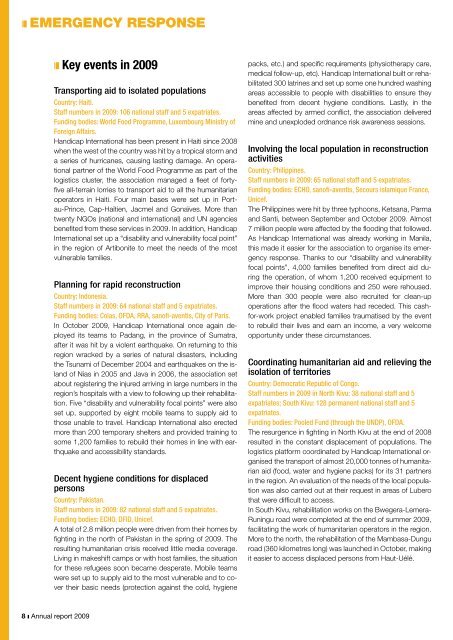Annual report 2009 - Handicap International
Annual report 2009 - Handicap International
Annual report 2009 - Handicap International
Create successful ePaper yourself
Turn your PDF publications into a flip-book with our unique Google optimized e-Paper software.
xz Emergency responsexz Key events in <strong>2009</strong>Transporting aid to isolated populationsCountry: Haiti.Staff numbers in <strong>2009</strong>: 106 national staff and 5 expatriates.Funding bodies: World Food Programme, Luxembourg Ministry ofForeign Affairs.<strong>Handicap</strong> <strong>International</strong> has been present in Haiti since 2008when the west of the country was hit by a tropical storm anda series of hurricanes, causing lasting damage. An operationalpartner of the World Food Programme as part of thelogistics cluster, the association managed a fleet of fortyfiveall-terrain lorries to transport aid to all the humanitarianoperators in Haiti. Four main bases were set up in Portau-Prince,Cap-Haïtien, Jacmel and Gonaïves. More thantwenty NGOs (national and international) and UN agenciesbenefited from these services in <strong>2009</strong>. In addition, <strong>Handicap</strong><strong>International</strong> set up a “disability and vulnerability focal point”in the region of Artibonite to meet the needs of the mostvulnerable families.Planning for rapid reconstructionCountry: Indonesia.Staff numbers in <strong>2009</strong>: 64 national staff and 5 expatriates.Funding bodies: Colas, OFDA, RRA, sanofi-aventis, City of Paris.In October <strong>2009</strong>, <strong>Handicap</strong> <strong>International</strong> once again deployedits teams to Padang, in the province of Sumatra,after it was hit by a violent earthquake. On returning to thisregion wracked by a series of natural disasters, includingthe Tsunami of December 2004 and earthquakes on the islandof Nias in 2005 and Java in 2006, the association setabout registering the injured arriving in large numbers in theregion’s hospitals with a view to following up their rehabilitation.Five “disability and vulnerability focal points” were alsoset up, supported by eight mobile teams to supply aid tothose unable to travel. <strong>Handicap</strong> <strong>International</strong> also erectedmore than 200 temporary shelters and provided training tosome 1,200 families to rebuild their homes in line with earthquakeand accessibility standards.Decent hygiene conditions for displacedpersonsCountry: Pakistan.Staff numbers in <strong>2009</strong>: 82 national staff and 5 expatriates.Funding bodies: ECHO, DFID, Unicef.A total of 2.8 million people were driven from their homes byfighting in the north of Pakistan in the spring of <strong>2009</strong>. Theresulting humanitarian crisis received little media coverage.Living in makeshift camps or with host families, the situationfor these refugees soon became desperate. Mobile teamswere set up to supply aid to the most vulnerable and to covertheir basic needs (protection against the cold, hygienepacks, etc.) and specific requirements (physiotherapy care,medical follow-up, etc). <strong>Handicap</strong> <strong>International</strong> built or rehabilitated300 latrines and set up some one hundred washingareas accessible to people with disabilities to ensure theybenefited from decent hygiene conditions. Lastly, in theareas affected by armed conflict, the association deliveredmine and unexploded ordnance risk awareness sessions.Involving the local population in reconstructionactivitiesCountry: Philippines.Staff numbers in <strong>2009</strong>: 65 national staff and 5 expatriates.Funding bodies: ECHO, sanofi-aventis, Secours islamique France,Unicef.The Philippines were hit by three typhoons, Ketsana, Parmaand Santi, between September and October <strong>2009</strong>. Almost7 million people were affected by the flooding that followed.As <strong>Handicap</strong> <strong>International</strong> was already working in Manila,this made it easier for the association to organise its emergencyresponse. Thanks to our “disability and vulnerabilityfocal points”, 4,000 families benefited from direct aid duringthe operation, of whom 1,200 received equipment toimprove their housing conditions and 250 were rehoused.More than 300 people were also recruited for clean-upoperations after the flood waters had receded. This cashfor-workproject enabled families traumatised by the eventto rebuild their lives and earn an income, a very welcomeopportunity under these circumstances.Coordinating humanitarian aid and relieving theisolation of territoriesCountry: Democratic Republic of Congo.Staff numbers in <strong>2009</strong> in North Kivu: 38 national staff and 5expatriates; South Kivu: 128 permanent national staff and 5expatriates.Funding bodies: Pooled Fund (through the UNDP), OFDA.The resurgence in fighting in North Kivu at the end of 2008resulted in the constant displacement of populations. Thelogistics platform coordinated by <strong>Handicap</strong> <strong>International</strong> organisedthe transport of almost 20,000 tonnes of humanitarianaid (food, water and hygiene packs) for its 31 partnersin the region. An evaluation of the needs of the local populationwas also carried out at their request in areas of Luberothat were difficult to access.In South Kivu, rehabilitation works on the Bwegera-Lemera-Runingu road were completed at the end of summer <strong>2009</strong>,facilitating the work of humanitarian operators in the region.More to the north, the rehabilitation of the Mambasa-Dunguroad (360 kilometres long) was launched in October, makingit easier to access displaced persons from Haut-Uélé.8 ı <strong>Annual</strong> <strong>report</strong> <strong>2009</strong>
















